Wooden windows reliably protect the house from bad weather and street noise. To keep them strong and attractive for many years, they periodically renew the paintwork of the frames. Knowing about the different materials will help you make the right choice for your window paint.
Requirements for paint for windows
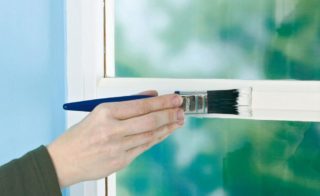
The type of paint and varnish material (LKM) is selected taking into account the characteristics of the surface and operating conditions. There are different requirements for paint for window frames depending on their location inside or outside the room. The outdoor surface must be able to withstand temperature extremes, frost and precipitation. From the material for interior work is required resistance to abrasion, detergents, preservation of color brightness.
A good window paint should have the following properties:
- The composition should not contain components harmful to human health.
- Lack of a sharp unpleasant odor that lingers in the room for a long time.
- Flame retardant and antiseptic additives that improve fire safety and resistance to mildew and mildew.
- Vapor permeability - moisture must pass through the decorative layer, otherwise condensation accumulated under the coating will lead to swelling.
- Fast drying - setting time can be from a few hours to 1-2 days. The parameter is influenced by the temperature and humidity of the environment, the number of layers. For outdoor work, it is worth choosing a paint and varnish material with a short setting time, so that it is not damaged by precipitation and mechanical stress until a strong film is formed.
- The paint should be covering, evenly lay down on the surface of the frames, not spread.
One of the selection criteria is a glossy or matte finish. The characteristic depends on the amount of polymer resins. A glossy glossy layer is more durable and moisture resistant, and a matte layer hides inaccuracies in the preparation of the base.
The choice of coloring composition

The type of paintwork depends on the substrate. Experts advise three main types of coverage.
Acrylic
Water-dispersed compositions in which the binder is an acrylic polymer, this is the best option for odorless window paint. They do not have toxic constituents and dry quickly. The paint and varnish material forms a durable film that, after drying, is not afraid of frost, moisture and burnout. The acrylic layer is vapor-permeable, which allows moisture from the frames to evaporate into the air. The paint spreads easily over the surface, suitable for indoor and outdoor use.
Alkyd
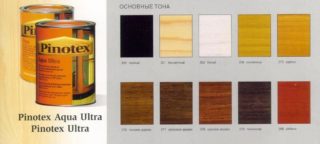
The basis of paintwork materials are artificial polymers in the form of alkyd resins or varnish. White spirit is used as a solvent, marble and granite chips are used as filler. The color palette of paint is small, but you can make the desired shade by adding a color scheme. The composition penetrates well into wood, on the surface it forms an elastic and durable coating that is resistant to abrasion and weathering. Alkyd paints and varnishes are produced in the form of enamel and oil solution. Their disadvantage is an unpleasant odor that does not disappear until it dries completely.
Oil
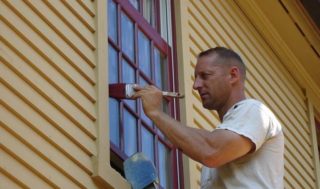
When choosing paint for window trims on the outside, you can use an oil composition. Its main disadvantage is a persistent chemical smell, but on the street it will not harm your health. The paint and varnish material consists of natural or artificial varnish, pigment and filler. On the surface, oil paints form a dense, water-repellent film. They are resistant to low temperatures, undemanding to maintain, and last at least 5 years. Long drying time (2 days), yellowing over time, pungent odor - these shortcomings make one give preference to other types of paintwork materials.
The durability and stability of the decorative coating depends on the chosen base of the coloring composition. Additional qualities (frost resistance, fire resistance, moisture resistance, etc.) are determined by auxiliary additives.
Preparation of the base
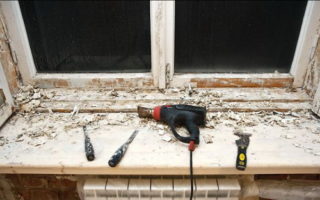
To reduce the consumption of paints and varnishes, to improve adhesion to a wooden surface and to eliminate frame defects, the base is prepared. Stages of work:
- Dismantle handles, latches and old dry glazing beads.
- Remove old coating. For this, several methods are used: the paint is heated with a construction hairdryer, cleaned with a spatula, and treated with a special wash. Complete stripping is done with a metal brush or sandpaper.
- Cover the glass with masking tape to protect it from contamination.
- Irregularities on the frames need to be putty, the solution is applied in several layers, each is sanded. After work, the dust is carefully removed. The surface should be as flat and smooth as possible.
- Resin may come out on softwood frames. Its drips are removed with a solvent - white spirit, acetone. Then the surface is wiped with soapy water.
- Treat wooden frames with an antiseptic to prevent mold.
- Cover the dried surface with primer, preferably in several layers. This will penetrate deeper into the fibers and protect the base.
- They start painting after the soil is completely absorbed, otherwise the coating will lie unevenly.
Before painting the windows, the frames are dismantled by removing them from the hinges. After removing the glazing beads or putty, the glass is removed from them. Disassembled frames are painted over completely.
Required tools and materials
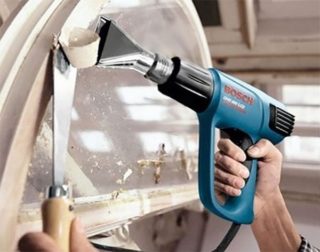
To prepare the base and paint you will need:
- putty knife;
- building hair dryer, metal brush or remover to remove old coating;
- sandpaper;
- plane;
- brushes of different sizes;
- roller;
- containers for paint;
- masking tape;
- screwdriver;
- a hammer;
- chisel;
- White Spirit.
The number of tools depends on the volume of restoration work. If the frames are in good condition or have just been purchased, preparation will not take much time and effort.
Features of DIY painting work
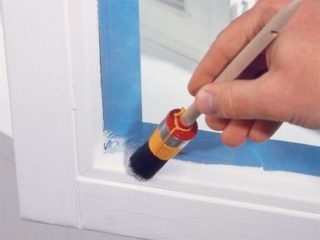
The paint is mixed, a part is poured into a container (plastic cuvette) and diluted with a solvent to a liquid consistency. This mixture is used for the first coat. It easily penetrates into the pores of the wood, and is fixed on the base. After a break for drying, a second layer is applied, the paint is taken at normal density. If necessary, paint with a third layer, but this is a rare case, a thick coating can flake off.
First, the coloring composition is applied to horizontal parts, then to a vertical surface. The adhesive tape is torn off immediately at the end of the work, until the composition has dried. If the glasses were removed, they are inserted after the paint has dried. A sealant is applied along the perimeter, then putty or glazing bead is stuffed. The last step is the frames are inserted into place.
White paint for window frames is a classic design option. The modern interior design of the apartment allows for other shades of coverage.The main requirement is that they must be in harmony with other elements of the room.
In order for the window to have a complete look, it is necessary to paint the slopes. It is best to finish with acrylic paint on the walls and ceiling. The water-based composition is suitable for plasterboard and plaster slopes. Before starting work, frames and glass are pasted over with masking tape. Paintwork materials are applied with brushes and a roller. At the end of the painting, the protection is removed.
Helpful hints
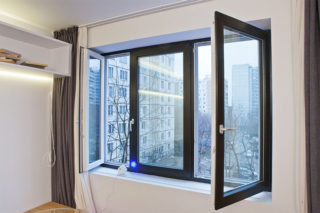
The advice of experts will be useful to those who decided to update the windows on their own:
- Painting work is performed on a dry, warm and calm day. At high temperatures, the paint will thicken and dry too quickly, in windy weather, debris can get on the coating. High humidity is the most dangerous factor, water reduces adhesion to the base, after a while swelling and cracks will appear.
- The inner corners are painted with a thin brush, even areas with a roller. Do not take on a lot of composition, otherwise drips will form. The defects that appear are immediately removed by rolling with a roller.
- To apply the primer, it is recommended to use a medium-width paint brush, so the composition is less sprayed.
- Under the oil paint, the frames are treated with linseed oil.
Windows are an important element in the design of a room. High-quality painting is the best way to improve their decorative appeal.








